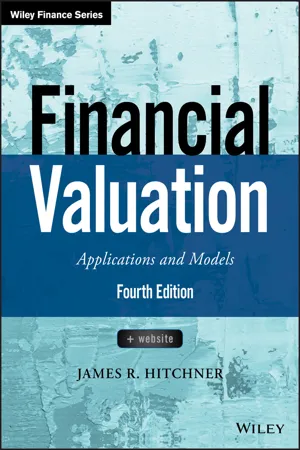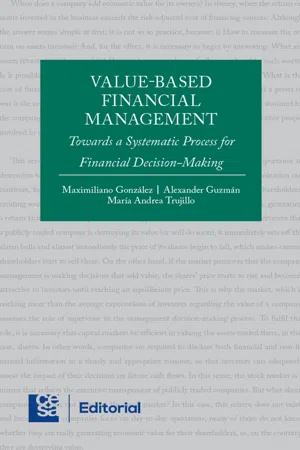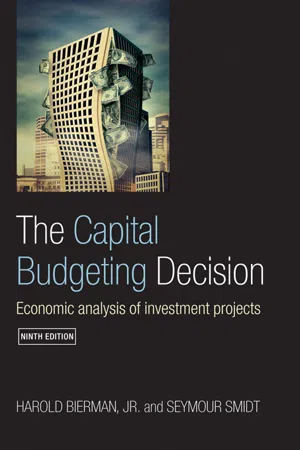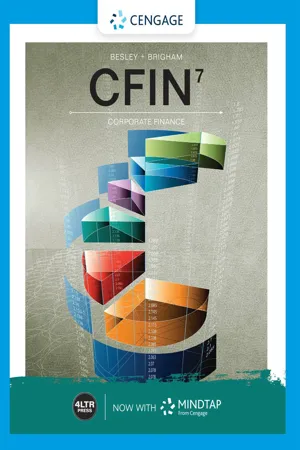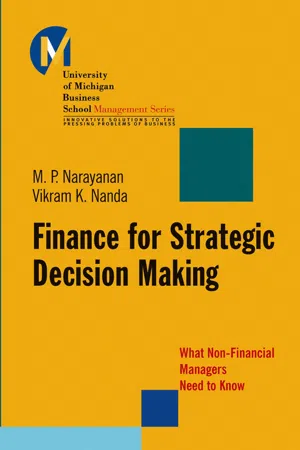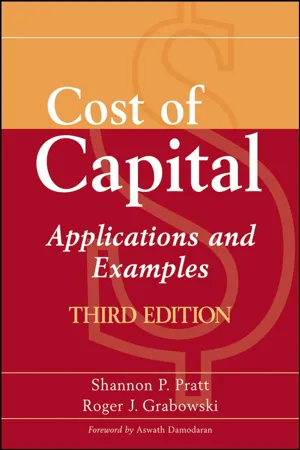Business
Weighted Average Cost of Capital
The Weighted Average Cost of Capital (WACC) is a financial metric that represents the average cost of capital for a company, taking into account the proportion of each type of capital used. It is calculated by weighting the cost of equity and the cost of debt according to their respective proportions in the company's capital structure. WACC is used as a discount rate in valuation models and investment decision-making.
Written by Perlego with AI-assistance
Related key terms
1 of 5
12 Key excerpts on "Weighted Average Cost of Capital"
- eBook - PDF
- E. Porras(Author)
- 2010(Publication Date)
- Palgrave Macmillan(Publisher)
The Weighted Average Cost of Capital (WACC) refers to the cost of all the fi- nancial resources a corporation uses. For the fund user, it would be the equiva- lent of the portfolio of returns we just mentioned for the lender. Either way, for a borrower or as a lender, each project accepted adds a specific level of risk to the portfolio of investments. Hence, in discounting the cash flows from the proposed project, this forward-looking risk must be taken into consideration. The Weighted Average Cost of Capital (WACC) The Weighted Average Cost of Capital (WACC) is the average cost of the per- manent financial resources of a firm. The formula for the WACC reaches the average by performing a ‘weighted addition’ of the capital structure compo- nents multiplied by their costs. The model is concerned with determining the components of the capital structure of the firm, their relative weights and the cost of each of the sources of funds. Given that each firm’s capital structure is different, a firm’s WACC might have any number of terms, each representing a source of funds. However, it will always have two: debt and common equity. A starting point for understanding 56 The Cost of Capital these costs would be to use the right-hand side of the balance sheet of the firm to identify the components of its capital structure. An overall guideline is to consider all components used for the long-term financing of the operations and, in addition, any significant amounts of short-term debt that are renewed annually, which de facto would be a permanent part of the capital structure of the company. - No longer available |Learn more
Financial Valuation
Applications and Models
- James R. Hitchner(Author)
- 2017(Publication Date)
- Wiley(Publisher)
Three basic types of capital form the capital structure of most business entities: 1. Common equity 2. Preferred equity 3. Long-term debt Each of these components has a cost associated with it. The definition of the Weighted Average Cost of Capital (WACC) is the blended cost of the company’s capital structure components, each weighted by the market value of that capital component. The use of a WACC method to determine value can be appropriate in many situ- ations, including when the objective is to value the entire capital structure of the enterprise or invested capital, such as in an acquisition where the buyer believes the current capital structure may not be optimal and intends to change it. In this situa- tion, a WACC can be developed for several capital structure scenarios (more debt, less debt, debt of different types with different rates, etc.) as a way for the buyer to try out different approaches to enterprise financing. Calculating the WACC A company’s WACC is calculated in three steps: 1. Determine the proportionate weighting of each source of capital financing based on its market value. 12 Ibid., 10. Cost of Capital/Rates of Return 191 2. Calculate the after-tax rate of return (cost) of each source. 3. Calculate the weighted average cost of all sources. The traditional formula used to develop a WACC is: WACC k W k W k 1 t W e e p p d/ pt d = × + × + - × ( ) ( ) [ ( ) ] ( ) Where: WACC = Weighted Average Cost of Capital k e = Cost of common equity capital W e = Percentage of common equity in the capital structure, at market value k p = Cost of preferred equity W p = Percentage of preferred equity in the capital structure, at market value k d/(pt) = Cost of debt (pre-tax) t = Tax rate W d = Percentage of debt in the capital structure, at market value This same WACC formula can be conveyed in a tabular format. - eBook - ePub
Value-based financial management
Towards a Systematic Process for Financial Decision - Making
- Maximiliano González Ferrero, Alexander Guzmán Vásquez, María Andrea Trujillo Dávila(Authors)
- 2021(Publication Date)
- CESA(Publisher)
Chapter 5Weighted Average Cost of Capital (WACC)T his chapter addresses the topic of how to estimate the Weighted Average Cost of Capital (WACC). As discussed in the previous chapters, there are two important ratios to evaluate the performance of companies: the ROIC, which was described in Chapter 3 , and the IRR, which was addressed in Chapter 4 . It was also pointed out that the IRR on free cash flows is equivalent to the ROIC or OROA but calculated under a dynamic approach and not for one specific year; additionally, it starts from the cash obtained from operations and not from the operating profit after tax. However, these two ratios that reflect what the company is generating in terms of return do not reflect what it should generate in terms of the risk taken by financing providers (debt and equity), nor the investment opportunities available on the market. The WACC is the parameter that allows determining the minimum return the company should deliver to its financing providers.Figure 9 shows the decision-making process that is being described here.Figure 9. WACCAs already explained, the WACC or Weighted Average Cost of Capital represents the expected return for financing providers, that is, debt and equity. The accounting equation A = D + E indicates that the assets of a company are financed with a ratio of debt and equity. In both cases, both the provider of debt capital and the provider of equity capital must not only face a risk, but also give up other investment opportunities on the market; therefore, they demand to be compensated.If, for example, the company has a high risk of bankruptcy given its high level of indebtedness, the cost of debt, rD , will increase until compensating the financial creditor; on the other hand, if shareholders perceive a high operational and financial risk, the demanded return on the money invested in the firm, rE , will increase accordingly.Although risk is always given a negative connotation, it is not necessarily bad. In our context, the term risk refers to deviations from a certain expected value. Let us suppose that investment A generates two possible scenarios with equal probability: one where a payment of $110 is obtained, and another with a payment of 90. In this case, the expected value of investment A is: - eBook - ePub
The Capital Budgeting Decision
Economic Analysis of Investment Projects
- Harold Bierman, Jr., Seymour Smidt(Authors)
- 2012(Publication Date)
- Routledge(Publisher)
When capital budgeting with time discounting was first introduced in the business finance literature in the early 1950s, the common recommendation was that an investment was acceptable if the net present value was positive using the firm’s Weighted Average Cost of Capital (WACC) as the discount rate (or, equivalently, if the investment’s internal rate of return was greater than the firm’s Weighted Average Cost of Capital). Even today, more business firms are using the firm’s Weighted Average Cost of Capital as the hurdle rate than any other required return. This utilization makes the cost of capital calculation of great importance. Although we do not endorse the general use of the firm’s cost of capital in the capital budgeting process as a single hurdle rate, it nevertheless is used; thus we should compute it in a reasonable manner. The same general approach can be used to compute a project’s cost of capital or a cash flow component’s cost of capital.There is also the question of how the asset’s value is affected by the financial mix decision. The following theories deserve consideration.- The value of a firm and the consequent wealth position of the stockholders is not affected by the type of financing.
- There is an optimum capital structure and the utilization of this structure will maximize the value of the firm.
- Given the present corporate tax laws, a firm should use as much debt as possible to maximize its value and the wealth position of its stockholders.
- The use of debt offers a tax advantage but it also increases the expected costs of financial distress.
- Given the presence of personal taxes as well as corporate taxes, common stock may have tax advantages compared to debt by means of tax deferral as well as preferential treatment of capital gains and dividends.
In this chapter we examine and evaluate each of these theories and the role the Weighted Average Cost of Capital plays in the capital structure and capital budgeting decisions. The key symbols to be used are:k0 = the weighted average after-tax cost of capital ki = the before-tax average cost of debt, ki (1−tc ) the after-tax cost of debt ke = the after-tax average cost of equity capital B = the market value of the debt in the capital structure S = the market value of the stock equity in the capital structure V = the total market value of the firm: Vu is the value of an unlevered firm; VL is the value of a levered firm tc = the corporate tax rate. Definition
The Weighted Average Cost of Capital (k0 or WACC) is defined as the sum of the weighted costs of debt (ki ) and equity capital (ke ), where the weights are the relative importance of each in the firm’s capital structure and the ki and ke - eBook - PDF
- Scott Besley, Eugene Brigham, Scott Besley(Authors)
- 2021(Publication Date)
- Cengage Learning EMEA(Publisher)
11-2a Determining WACC Each firm has an optimal capital structure—a mix of debt, preferred stock, and common equity that causes its stock price to be maximized. Therefore, a rational, value- maximizing firm will establish a target (optimal) capital structure and then raise new capital in a manner that will keep the actual capital structure on target over time. In this chapter, we assume that the firm has identified its optimal capital structure, it uses this optimum as the target, and it raises funds so it constantly remains on target. How the target is established will be examined in Chapter 12. The target proportions of debt, preferred stock, and common equity, along with the component costs of capital, are used to calculate the firm’s Weighted Average Cost of Capital (WACC). The WACC simply rep- resents the average cost of each dollar of fi- nancing, no matter its source, the firm uses to purchase assets. That is, WACC represents the minimum rate of return the firm must earn on its investments (assets) to maintain its current value. To illustrate, sup- pose Unilate Textiles has determined in the future it will raise new capital according to the fol- lowing proportions: 45 VERSUSstudio/Shutterstock.com target (optimal) capital structure The combination (percentages) of debt, preferred stock, and common equity that will maximize the price of the firm’s stock. weighted average cost of capital (WACC) A weighted average of the component costs of debt, preferred stock, and common equity; the average cost of each dollar the firm uses to purchase (invest in) assets. 259 CHAPTER 11: The Cost of Capital Copyright 2022 Cengage Learning. All Rights Reserved. May not be copied, scanned, or duplicated, in whole or in part. Due to electronic rights, some third party content may be suppressed from the eBook and/or eChapter(s). Editorial review has deemed that any suppressed content does not materially affect the overall learning experience. - eBook - ePub
- Robert Irons(Author)
- 2019(Publication Date)
- Routledge(Publisher)
When a firm borrows money (issues new debt), both its financial leverage and its financial risk increase. When a firm issues new common equity, its financial leverage decreases. If the firm issues both new debt and new equity, keeping the ratio of debt and equity relatively constant, then financial leverage remains fairly stable. As will be seen, each source of funds (debt vs. preferred equity vs. new common equity vs. retained earnings) has different costs. Therefore, firms are motivated to (A) use the mix of sources that results in the lowest overall cost of funds and (B) maintain that relationship between the sources over time to stabilize both their costs and their financial leverage. The overall cost of funds, weighted according to the firm’s use of the sources of funds, is known as the Weighted Average Cost of Capital, or WACC. The formula for calculating the WACC is:W A C C =W dk d(+1 − T)W pk p+W eke o r n- where:Wis the percentage of debt used in the capital structure;d
- Wis the percentage of preferred equity used in the capital structure;p
- Wis the percentage of common equity used in the capital structure;e
- kis the component cost of debt (the appropriate interest rate);d
- kis the component cost of preferred equity;p
- kis the component cost of common equity using retained earnings;e
- kis the component cost of new common equity (floating new shares); andn
- T is the firm’s marginal tax rate.
Notice that the cost of common equity is given in two different forms: the cost of retained earnings (kTwo important things to understand about this model:) and the cost of issuing new common equity (ke). As will be seen, these two sources have different costs, and therefore need to be treated separately.n- For the cost of common equity, kis used in the model before kebecause retained earnings are cheaper than new common equity (knis used when the firm runs out of retained earnings); andn
- The weights (W, Wdand Wp) must sum to 100%.e
The firm’s capital is supplied by its shareholders (owners and preferred shareholders) and its bondholders (creditors). The firm owes its investors a reasonable return—reasonable by the investors’ standards, not the firm’s. At the same time, the returns paid to the investors have a direct impact on the value of the firm’s investments, as well as the value of the firm itself. Therefore, it is in the firm’s best interests to minimize the cost of the money it receives. It is also in the investors’ best interests for the firm to minimize its costs; the lower the cost of the debt used, the more likely the firm will be in a position to pay the debt on time and in full. Likewise, the lower the cost of the funds used, the higher the present value of the firm’s cash flows, and therefore the higher the intrinsic value of the firm’s stock. So, minimizing the firm’s cost of capital is in the best interests of the firm and its stakeholders. - eBook - ePub
Finance for IT Decision Makers
A practical handbook
- Michael Blackstaff(Author)
- 2012(Publication Date)
- BCS, The Chartered Institute for IT(Publisher)
Lenders to a company will usually be prepared to accept a lower return than shareholders, because lending is less risky. There are two reasons for this. First, payment of interest on a loan is compulsory, while dividends are not. Second, lenders have more security than do shareholders. They have a higher priority for getting paid when a company is wound up, so they stand more chance of getting their money back should it fail.Weighted Average Cost of Capital (WACC)So, what is a particular company’s cost of capital? It is a combination of its cost of equity and its cost of debt. If there were equal quantities of equity and debt, then the cost of capital would be the average of the two. Because the respective quantities are usually unequal, a weighted average is required. So, a company’s cost of capital is the weighted average of its costs of equity and debt. The following example illustrates the calculation and introduces the effect of tax.Let us assume for simplicity that a company has CU3 million of equity and CU1 million of debt. The total capital employed is therefore CU4 million. Suppose that the ‘cost of equity’ is 12 per cent per annum and the cost of debt eight per cent. What is the company’s current ‘cost of capital’? The calculation is as follows:(3 / 4 × 12) + (1 / 4 × 8) = 9 + 2 = 11%Therefore the basis of the discount rate used by this particular company in discounted cash flow calculations would be 11 per cent, but only if the company ignores tax in such calculations. Dividends are paid out of already-taxed profit. Interest on business loans, however, unlike interest on personal loans, is usually an expense deductible in arriving at profit. Therefore, the true cost of loan interest is not its gross cost but its net-of-tax cost. If the tax rate paid by the above company is, for example, 30 per cent, then the net-of-tax cost is not eight per cent but 5.6 per cent. To arrive at the after-tax cost of capital, the above calculation would be restated as follows:(3 / 4 × 12) + (1 / 4 × 5.6) = 9 + 1.4 = 10.4%Not all organisations are taxable and not all businesses take tax into account in investment evaluations. However, many do, and that is why a chapter on tax (Chapter 7 - eBook - PDF
- Timothy Mayes(Author)
- 2020(Publication Date)
- Cengage Learning EMEA(Publisher)
All Rights Reserved. May not be copied, scanned, or duplicated, in whole or in part. Due to electronic rights, some third party content may be suppressed from the eBook and/or eChapter(s). Editorial review has deemed that any suppressed content does not materially affect the overall learning experience. Cengage Learning reserves the right to remove additional content at any time if subsequent rights restrictions require it. CHAPTER 11 The Cost of Capital 344 refer to this minimum required rate of return as the Weighted Average Cost of Capital (WACC). The WACC can be found as follows: WACC 5 w d k d 1 w P k P 1 w cs k cs (11-1) where the w’s are the weights of each source of capital and the k’s are the after-tax costs (required returns) for each source of capital. In the case of RMM, the WACC is: WACC 5 0.40(0.07) 1 0.10(0.10) 1 0.50(0.12) 5 0.098 5 9.80% which is exactly the required return that we found earlier. Determining the Weights The weights that one uses in the calculation of the WACC will obviously affect the result. Therefore, an important question is, “Where do the weights come from?” Actu- ally, there are three possible answers to this question. Perhaps the most obvious answer is to find the weights on the balance sheet. The balance sheet weights (usually referred to as the book-value weights) can be obtained by the following procedure: Find the total long-term debt, total preferred equity, and the total common equity. Add together each of these to arrive at the grand total of the long-term sources of capital. Finally, divide each component by the grand total to discover the percentage that each source is of total capital. Table 11-3 shows these calculations for RMM. The problem with book-value weights is that they represent the weights as they were when the securities were originally sold. That is, the book-value weights represent historical weights. The WACC would better represent current reality if we used the present weights. - eBook - PDF
- Robert Parrino, David S. Kidwell, Thomas Bates(Authors)
- 2016(Publication Date)
- Wiley(Publisher)
If the cost of the debt for this business is 6 per cent and the cost of the equity is 10 per cent, the cost of capital for the firm can be calculated as a weighted average of the costs of the debt and equity: 3 k x k x k = + = + = (0.075)(0.06) (0.925)(0.10) 0.097, or 9.7% Firm Debt Debt Equity Equity Notice that we have used Equation 13.2 to calculate a Weighted Average Cost of Capital (WACC) for the firm in this example. In fact, this is what people typically call the firm’s cost of capital, k Firm . From this point on, we will use the abbreviation WACC to represent the firm’s overall cost of capital. Weighted Average Cost of Capital (WACC) The weighted average of the costs of the different types of capi-tal (debt and equity) that have been used to finance a firm; the cost of each type of capital is weighted by the proportion of the total capital that it represents. Learning by Doing Application 13.1 ■ CALCULATING THE COST OF CAPITAL FOR A FIRM PROBLEM You are a real estate investor who is consider-ing investing in a new office building that will cost €2 000 000. You plan to finance the building with a €1 500 000 first mortgage at a 6.5 per cent interest rate, a €300 000 sec-ond mortgage at an 8 per cent interest rate and €200 000 of your own money. You will own all of the equity (shares) in this investment. You estimate that the opportunity cost of your €200 000 investment – that is, what you could earn on an investment of similar risk in the capital market – is 12 per cent with that much debt. What is the cost of capital for this investment? APPROACH You can think of the office building as a separate firm and use Equation 13.2 to calculate the WACC for this ‘firm’. Since you are planning to finance the building with capital from three different sources – two mortgages and your own equity investment – the right-hand side of Equation 13.2 will have three terms. - eBook - PDF
The Cost of Capital
Theory and Estimation
- Cleveland S. Patterson(Author)
- 1995(Publication Date)
- Praeger(Publisher)
Its main limitation is that it is only applicable to assets that have the same systematic risks and incremental debt ratio as the traded entity used to estimate its magnitude. In general, for assets that do not meet this criterion, it is still necessary to estimate a project-specific level of /cj 7 . Methods for doing this are discussed in Chapter 9. IV. ESTIMATION OF THE Weighted Average Cost of Capital In order to calculate K(WACC) for a traded firm that has a capital structure containing only common equity and straight debt and preferred shares it is necessary to estimate the inputs in the expression K(WACC) = L b k b (l-T c )+ L p k p +L e k e (7.2 where L b , L p , and L e are market-value debt, preferred, and common equity ratios and T c is the marginal rate of corporate tax applicable to interest pay- ments by the firm. The rates k b , k p , and k e are current marginal costs of debt, preferred, and common equity for the firm. If flotation costs are included in the initial investment, C 0 , the three rates are equal to current market opportunity costs. More generally, for firms with complex capital structures that include (7.26)) Financing Effects and Weighted Average Cost 181 hybrid securities such as warrants and convertible securities, other value- weighted terms can be added to this expression as appropriate. The costs and valuation of such securities are discussed further within the framework of op- tion valuation in Chapter 11. It is important to emphasize that what is being estimated with Equation (7.26) is AT(WACC) for the traded firm as it is currently perceived by investors. Applicability of the resulting estimate of KQNACC) to a particular investment j rests on the crucial assumption, previously discussed, that the firm is a mirror image of the investment. - eBook - PDF
Finance for Strategic Decision-Making
What Non-Financial Managers Need to Know
- M. P. Narayanan, Vikram K. Nanda(Authors)
- 2004(Publication Date)
- Jossey-Bass(Publisher)
Since this is a weighted 58 Finance for Strategic Decision Making average, it is often referred to as the Weighted Average Cost of Capital (WACC). To find the WACC, we need three items: ■ Cost of debt ■ Cost of equity ■ Proportions of debt and equity For a pure play, these data either are available or can be esti-mated from publicly available data. Estimating Cost of Debt The cost of debt is the interest rate the company effectively pays on its debt. Clearly the cost of debt is easier to estimate than the cost of equity because the rate of interest is specified in the debt contract. The cost of debt of a project is, therefore, easy to obtain if your own company is the pure play for the project. If the pure play for the project is another company, a simple way to estimate the cost of debt of the pure-play company is to find the bond rating of that company and the yield (the effective rate of interest charged by investors) of similarly rated bonds. Such information is now easily available on the Internet. It is important to note that the interest rate a company ef-fectively pays is likely to be lower than the rate charged by in-vestors because of the tax-deductibility of interest payments. For example, if a company pays 8 percent interest on its debt and is in the 35 percent tax bracket, its after-tax cost of debt is only 8 percent 3 (1 2 0.35) 5 5.2 percent. Note equity payouts such as dividends have no similar tax break in the United States. Also, a company cannot take advantage of this tax-deductibility of interest in years in which the company does not earn an op-erating profit. In such years, the cost of debt will equal the rate charged by investors. Cost of Capital 59 Estimating Cost of Equity Unlike the cost of debt, the cost of equity is not specified con-tractually, for the simple reason that there cannot be a contract between the company and its legal owners. The owners simply receive what is left over after paying all claimants. - eBook - PDF
- Shannon P. Pratt, Roger J. Grabowski(Authors)
- 2008(Publication Date)
- Wiley(Publisher)
New York: McGraw-Hill, 2000. Bishop, David M., and Frank C. Evans. ‘‘Avoiding a Common Error in Calculating the Weighted Average Cost of Capital.’’CPA Expert (Fall 1997). Evans, Frank C., and Kelly L. Strimbu. ‘‘Debt and Equity Weightings in WACC.’’ CPA Expert (Fall 1998). Hitchner, James R., Financial Valuation: Applications and Models, 2nd ed. Hoboken: John Wiley & Sons 2006. Martin, Harold G., Jr. ‘‘Cost of Capital.’’ Joint presentation made with Ronald L. Seigneur at the American Institute of Certified Public Accountants National Business Valuation Conference, Las Vegas, NV, December 4, 2001. Pratt, Shannon P. Valuing a Business: The Analysis and Appraisal of Closely Held Companies, 5th ed. New York: McGraw-Hill, 2007. 296 Cost of Capital Appendix 17B Iterative Process Using CAPM to Calculate the Cost of Equity Component of the Weighted Average Cost of Capital When Capital Structure Is Changing James R. Morris, Ph.D Introduction Assumptions Inherent in Weighted Average Cost of Capital Solution: Iterative Process with Changing Capital Structure Iterative Process Using Financial Spreadsheet Model Stage 4 Stage 3 Stage 2 Stage 1 Stage 0 Handling the Iterations Equity Value Summary Additional Reading INTRODUCTION In Appendix 17A, Harold Martin explained how to use the iterative process to calculate the cost of capital and the value of the firm. The iterative process is necessary because the valuation problem is circular. That is, to calculate the cost of capital and the value of the firm, we need to know the value of the firm and value of its components—the debt and equity—which, in turn, are the things we are trying to determine. We use the iterative process to converge on value estimates where the values we use as input agree with the values we get as output. The purpose of this appendix is to build on the iterative process of Appendix 17A to show how to calculate the value of the firm and equity when the capital structure is changing over time. 297
Index pages curate the most relevant extracts from our library of academic textbooks. They’ve been created using an in-house natural language model (NLM), each adding context and meaning to key research topics.

